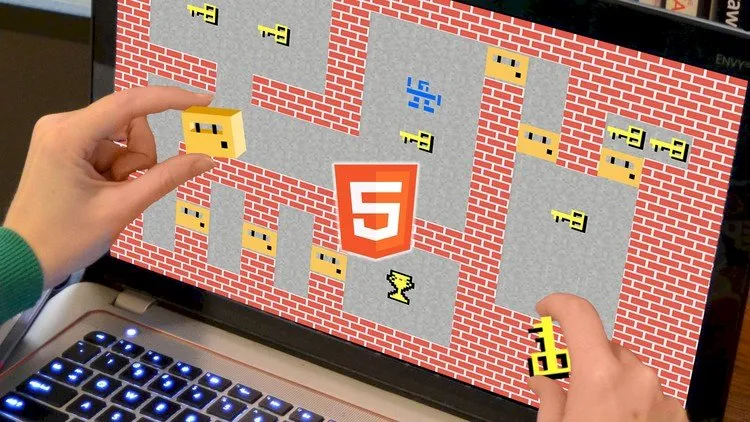How to Program Games: Tile Classics in JS for HTML5 Canvas
Learn to code tile-based worlds and related core gameplay for genres like arcade, overhead racing, and puzzle adventure.

How to Program Games: Tile Classics in JS for HTML5 Canvas udemy course free download
Learn to code tile-based worlds and related core gameplay for genres like arcade, overhead racing, and puzzle adventure.
What you'll learn:
- Create, display, and play with a 2D tile world that supports optimized collision (a central concept for generations of games in a variety of genres!)
- Program games in JavaScript for HTML5 Canvas without using any external libraries or plug-ins
- Create, load, display, and rotate image graphics in games
- Break game code into multiple files to better manage large projects
- Define a class and use it to create multiple instances of gameplay objects in unique positions (note: only using the very basic first concept of object-oriented programming, it doesn't dive deep into that rabbit hole)
- Handle mouse input for a one-player game, or keyboard controls for both one and two-player games
- Implement basic item pick-ups (keys) and trigger their usage upon collision (open doors)
- Develop and adapt gameplay for basic platformer movement, digital board/strategy games, simple matrix formations for retro arcade-style enemies, and worlds larger than the screen viewed by scrolling camera
- Apply simple trigonometry calls to move game objects at arbitrary angles
- Implement basic loading screen functionality in HTML5
Requirements:
- Any plain text editor like Notepad will do, however one which supports features for programmers such as multiple file tabs, code highlighting, line numbers, and smart/auto-indentation can be handy for later phases as the code grows in length (Notepad++ is free for Windows, TextWrangler for Mac, or Sublime Text 2 which I use has a fully functional free trial for either)
- Any common web browser should work fine, although I use Google Chrome (free) so you may prefer that one just to see on your side exactly how it shows up in the videos
- To follow along the few steps for drawing art you'll need a program that lets you draw and save images with transparency. I use a slightly older version of Photoshop, although free alternatives exist and the steps are similar. I also attach all art files that I create, so if you prefer to only focus on the coding steps you can download the images that I create in the videos.
Description:
By taking this new course you'll program several classic game types that all incorporate 2D tile-based worlds. You'll code in JavaScript for HTML5 Canvas, so a text editor and ordinary web browser are all you need (an art program can be handy for a few sections but is not required). I've attached my code for each step so you'll never be stuck. At the end you'll learn even more ways to apply what you've learned. Also by completing the course you'll get a PDF of my complete 500-page textbook on game development: Hands-On Intro to Game Programming. The book contains over 100 exercises, a couple of more game types, and additional material with more detail about the projects you created in this course.
(HTML5 Logo in the course image is by W3C, licensed under Creative Commons Attribution 3.0 Unported. Background pattern for transition cards CC BY-SA 3.0 Subtle Patterns © Atle Mo. drawn by Paul Phönixweiß.)
Who this course is for:
- Anyone who wants to learn practical skills to program their own games at home
- People who may aleady be familiar with programming concepts but are new to applying that knowledge to making real-time computer games
- Creators who have only ever tried drag-and-drop tools but are interested in learning more about how to make games by programming for an deeper level of control over the details
- Developers interested in getting practice with a more traditional "code only" approach to core gameplay programming before moving on to major engines and tools (which are not covered in this course) like Unity or Unreal
- People looking for a technical game design foundation based in indie-style games or classic gameplay as a starting point
- New developers who completed the free course "Code Your First Game: Arcade Classic in JavaScript on Canvas" and are looking to furthr build upon their game development skills in JavaScript on HTML5 Canvas
- Please note that advanced topics like object-oriented programming are only very briefly touched upon - software engineering patterns are generally outside the scope of this course
- Spring & Hibernate for Beginners (includes Spring Boot)
- Machine Learning A-Z™: Hands-On Python & R In Data Science
- React - The Complete Guide (incl Hooks, React Router, Redux)
- Microsoft Excel - Excel from Beginner to Advanced
Course Details:
-
5 hours on-demand video
-
148 downloadable resources
-
Full lifetime access
-
Access on mobile and TV
-
Certificate of completion
How to Program Games: Tile Classics in JS for HTML5 Canvas udemy courses free download
Learn to code tile-based worlds and related core gameplay for genres like arcade, overhead racing, and puzzle adventure.
Demo Link: https://www.udemy.com/course/how-to-program-games/

